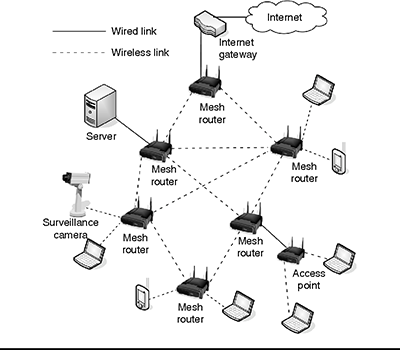SMART Wireless Mesh Networks
Autonomic Formation of Wireless Mesh Networks (WMN)
Surrounded by inequality in his native Brazil, Emory researcher Sergio Gramacho, PhD has always been interested in ways to improve access to information through connectivity. "I grew up with friends who came from rich families, and I grew up with friends and colleagues at school who had very little." But Gramacho realized that it's not just Brazil that is a "mixed bag of people with possibilities and people with low possibilities" -- noting that even very rich countries like the U.S. have serious limitations when it comes to connectivity. "More than 50% [of the population] is not properly connected." [according to research by Microsoft]
After a company merger gave Gramacho the time, money, and flexibility to work on passion projects for a year or so, he decided to focus on connectivity. But soon, he realized he would have to get creative with solutions because existing technology didn't meet his vision. "I realized what I wanted to do, didn't exist."
Gramacho began brainstorming solutions to existing problems with wireless mesh networks (WMNs). WMNs are a type of communications network composed of nodes that provide access to the system, for example, routers, organized in a mesh of linkages. Mesh nodes cooperate by forwarding data on behalf of each other to achieve wide coverage despite using short-range wireless links. Since fewer wired links are required, WMNs show great promise for enhancing connectivity over large regions at a low cost. However, since increasing the number of nodes does not increase its capacity, or the amount of traffic that a network can handle at any given time, capacity scaling issues still pose a challenge.
For WMNs to be widely adopted at large-scales, capacity scaling needs to be improved — and Gramacho's invention seeks to do just that. Gramacho, along with fellow Emory researchers, have developed a group of self-organizing, self-healing, and self-optimizing autonomic agents (the SMART class of agents) that take an existing WMN node placement and evolve it into interconnected partitions with improved capacity scaling. In multiple simulations with thousands of nodes, SMART showed fast convergence to stable partition configurations, and the agent design is able to overcome connectivity failures among the nodes, as well as additional variations in node placement density and scale. The design does not rely on any centralized network formation mechanism, turning appropriate for application in networks at large-scales.

Diagram of a Wireless Mesh Network *
The technology may sound complicated, but Gramacho insists that the idea was born out of a focus on simplicity taught to him by a mentor, who once said: "You won't always have the best solution at first, but if you have any solution, you can just build and get something good and try to solve the problem completely."
Gramacho also uses this problem-solving model to explain the complex technology behind his invention for those who may be less technologically savvy. "Let's imagine that we have a very, very complex problem that is very large in size. If we take a team of people and we split this problem into smaller problems, and we give all of them a small bit of the problem, it will turn this impractical problem into something that is possible to solve. If we do not require a final person who would consolidate all of the data to give the answer, if the answer could just be the aggregation of the answers of everyone, we've turned this complex problem into something much more simple." The nodes work in a similar manner, in which "all of the devices have their own responsibilities."
While the technology remains in the alpha stage and is not yet ready for installation, its potential for widespread impact has been recognized. In 2020, Gramacho's work was awarded the Office of Technology Transfer's Innovation of the Year. "Telecommunications might seem outside Emory's usual wheelhouse, but it's rare to come across a technology that has clear commercial potential while democratizing a resource as critical as internet connectivity," noted Sat Balachander, licensing associate in the Offic eof Technology Transfer. Looking ahead, Gramacho is just getting started. He successfully completed his PhD in the Spring of this year, and while he will be pursuing full-time roles outside of his work on WMN's, he has ambitious long-term plans for his technology. "Access to tech is so important," Gramacho believes, and he hopes that over time, this technology will be implemented and utilized in a way that improves access to telecommunications and information, and because of that, improves the overall economies and education systems of underdeveloped regions.
Techid: 19116